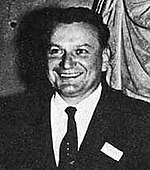Krafft Ehricke
| Krafft Arnold Ehricke | |
|---|---|

Krafft Arnold Ehricke
|
|
| Born |
March 24, 1917 Berlin, Germany |
| Died | December 11, 1984 (aged 67) La Jolla, California, United States |
Krafft Arnold Ehricke (March 24, 1917 – December 11, 1984) was a German rocket-propulsion engineer and advocate for space colonization.
Born in Berlin, Ehricke believed in the feasibility of space travel from a very young age, influenced by his viewing of the Fritz Lang film Woman in the Moon. At the age of 12, he formed his own rocket society. He attended Technical University of Berlin and studied celestial mechanics and nuclear physics under such luminaries as Hans Geiger and Werner Heisenberg, attaining his degree in Aeronautical Engineering.
He worked at Peenemünde as a propulsion engineer from 1942 to 1945 with Walter Thiel, then went to the United States with other German rocket scientists and technicians under "Operation Paperclip" in 1947. He worked for a short time with the Von Braun Rocket Team at Huntsville.
In 1948, while working for the U.S. Army, Ehricke wrote a story about a manned mission to Mars called "Expedition Ares". It anticipated the many challenges that still face explorers who will make the journey in the future. In the same year he wrote a book with Wernher von Braun, The Mars Project, which detailed how man could travel to Mars using a ferry system.
Upon leaving government service Ehricke worked at Bell Aircraft, and then for Convair in 1952. While at Convair, he designed the D-1 Centaur, the world's first upper-stage-booster that used liquid hydrogen and oxygen. He also created an early space station design, based on launch by Convair's Atlas rocket. The NEXUS reusable rocket was a 1960s concept design by a group at General Dynamics led by Krafft Ehricke. Also, during his stay at General Dynamics, he participated on Project Orion (nuclear propulsion).
...
Wikipedia
